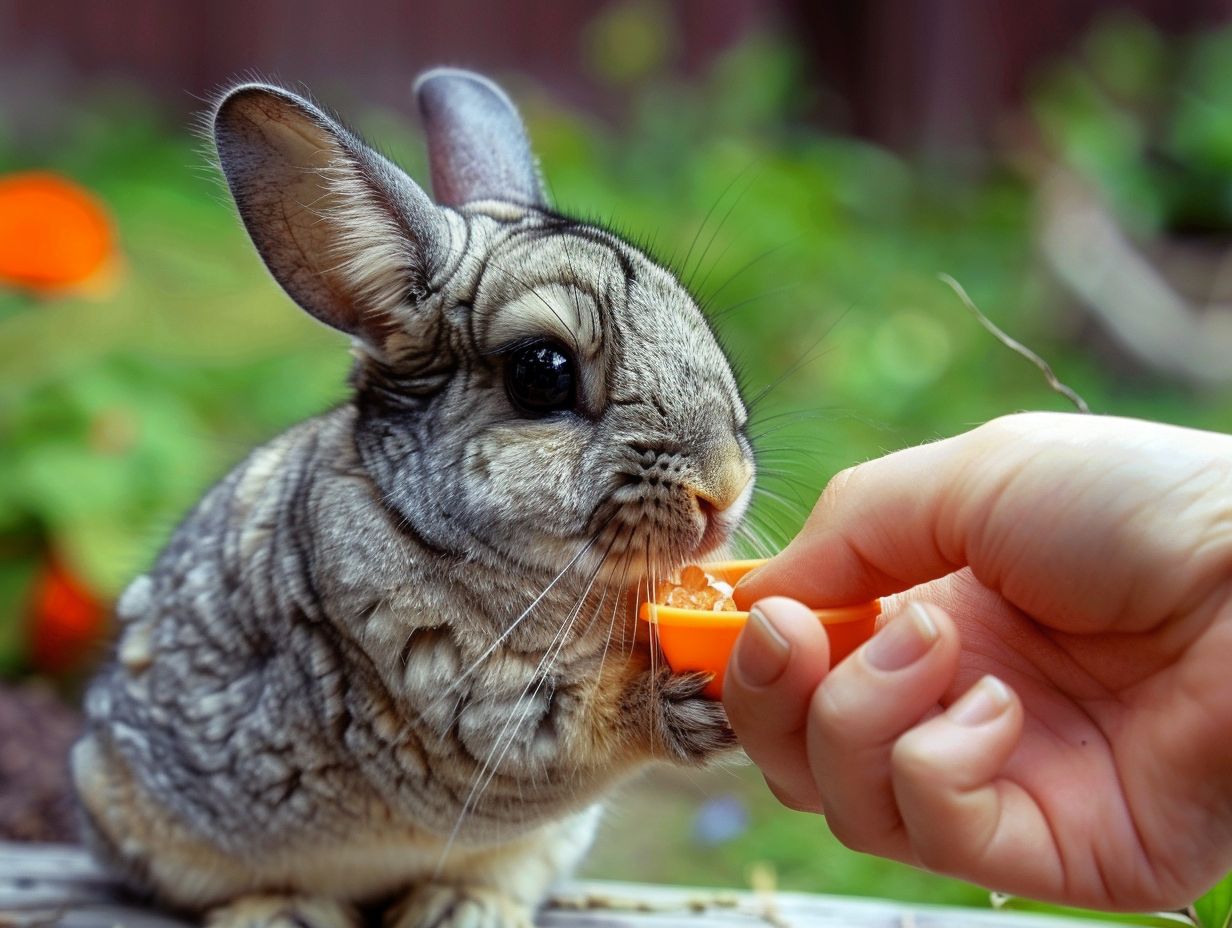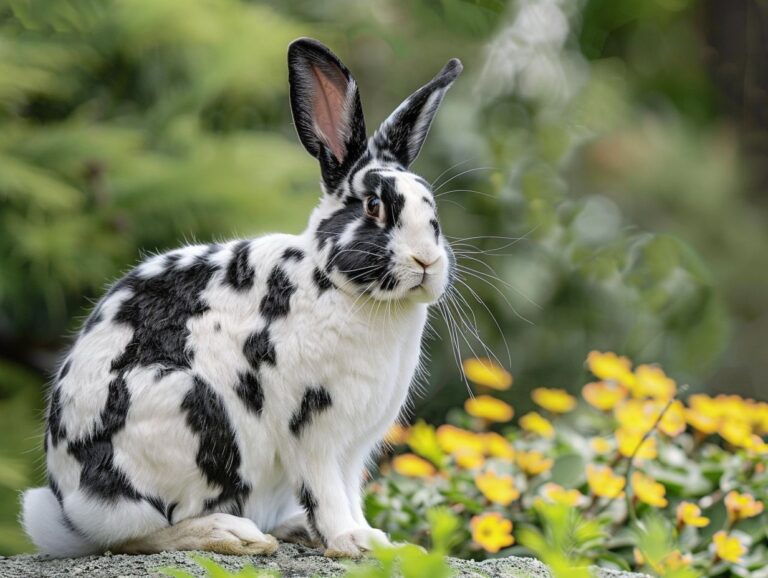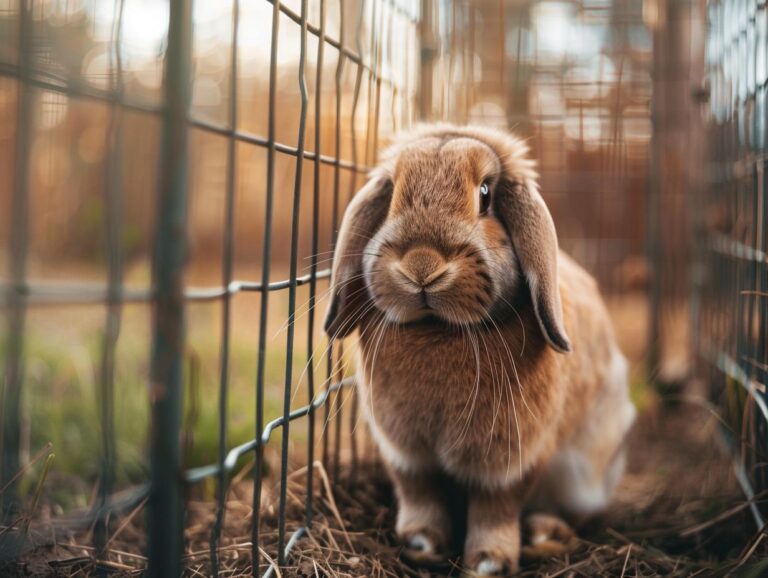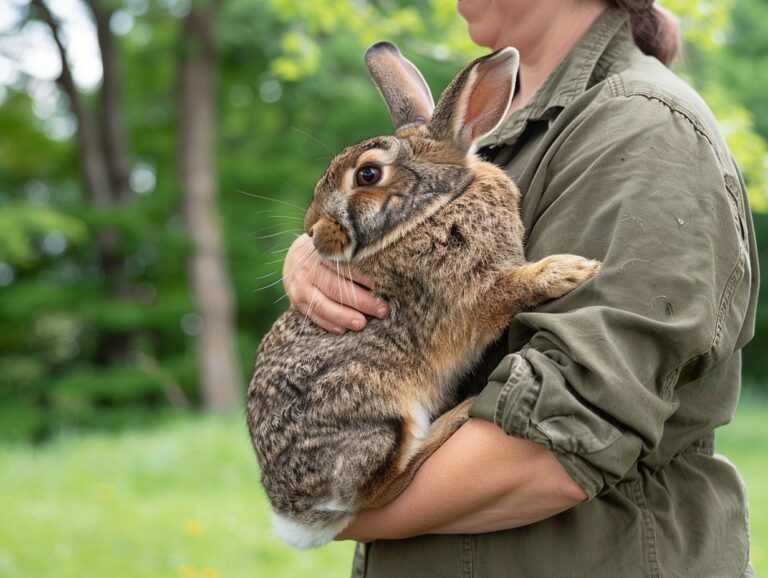Giant Chinchilla Rabbits As Pets: Care, Diet, and Health For Giant Sized Breeds
Are you considering adding a giant-sized rabbit breed to your family?
Giant Chinchilla Rabbits are a popular choice for those looking for a unique and lovable pet.
We will explore the physical characteristics and temperament of these gentle giants, as well as provide tips on how to care for them properly.
From their ideal living environment to recommended diets and grooming techniques, we will cover everything you need to know about owning a Giant Chinchilla Rabbit.
Let’s dive in!
Key Takeaways:
What Are Giant Sized Rabbit Breeds?
Giant Sized Rabbit Breeds are a group of rabbits that typically weigh 11 pounds or more. These breeds are known for their substantial size and unique characteristics that set them apart from smaller rabbit breeds.
These impressive rabbits showcase a range of physical attributes that are not only striking but also endearing. Their large, muscular bodies exude strength and elegance, making them stand out in the rabbit world. Despite their size, these giant rabbits are often gentle and docile, making them great companions for families or individuals seeking a unique pet. The Flemish Giant, Checkered Giant, and Giant Chinchilla are among the most popular breeds in this category, each offering distinct features and charm.
The origins of these large rabbit breeds can be traced back to different parts of the world, with histories that add intrigue to their allure. They have garnered a significant following within the rabbit community, with enthusiasts appreciating their beauty, temperament, and friendly nature. Whether it’s their majestic appearance or their gentle disposition, giant-sized rabbit breeds continue to captivate the hearts of many rabbit lovers around the globe.
What Are the Most Common Giant Sized Rabbit Breeds?
The most common giant-sized rabbit breeds include the Continental Giant, Flemish Giant Rabbits, and other recognized breeds by the British Rabbit Council. These breeds are popular for their size, unique appearances, and temperament.
The Continental Giant is known for its massive size, reaching up to 25 pounds or more, making it one of the largest rabbit breeds in the world. Their signature feature includes long, upright ears and a sleek, muscular body. Originating from Belgium, these rabbits are gentle and make great pets for experienced owners who can provide ample space for their large size.
Flemish Giant Rabbits, on the other hand, are prized for their friendly disposition and distinctive coat colors, such as sandy, black, blue, and white. Originating from Flanders, Belgium, these gentle giants can weigh up to 20 pounds or more. They require regular grooming due to their thick fur to prevent matting.
What Makes Giant Chinchilla Rabbits Unique as Pets?
Giant Chinchilla Rabbits stand out as unique pets due to their striking fur coloration, gentle demeanor, and manageable size despite being giant rabbits. Their heritage as a recognized breed like the American Chinchilla Rabbit adds to their appeal.
Their fur, which is a blend of blue-gray and white colors, creates a mesmerizing pattern that is not only visually appealing but also soft to the touch. This fur pattern is distinctively different from other rabbit breeds, making them stand out in the realm of pet rabbits.
In terms of temperament, Giant Chinchilla Rabbits are known for their friendly and docile nature, making them ideal companions for families with children. They are sociable animals that enjoy human interaction and can easily bond with their owners.
What Are the Physical Characteristics of Giant Chinchilla Rabbits?
The physical characteristics of Giant Chinchilla Rabbits include a large body size, distinctive fur coloration resembling the American Chinchilla Rabbit, and a friendly expression that reflects their gentle nature.
These rabbits are notably larger than the average domestic rabbit, with adult males weighing between 12-15 pounds and adult females slightly heavier at 13-16 pounds. The fur of Giant Chinchilla Rabbits features a unique tri-color pattern known as ‘pearl,’ which consists of black, white, and varying shades of grey. Their ears are upright, medium-sized, and sit elegantly atop their head, giving them an alert and endearing appearance.
One distinguishing feature that separates Giant Chinchilla Rabbits from other giant breeds like Coloured Continental Giants is their well-proportioned body shape and striking markings. Their size and markings often draw admiration from rabbit enthusiasts and breeders alike.
What Is the Temperament of Giant Chinchilla Rabbits?

These rabbits are known for their outgoing nature and curiosity, often approaching humans without fear. Their adaptability to human interaction makes them excellent pets, enjoying being gently petted and handled. Giant Chinchilla Rabbits also exhibit a high level of sociability, thriving in environments where they can interact with people regularly. When raised in households with other pets, they generally get along well, especially if introduced gradually and under supervision.
With children, Giant Chinchilla Rabbits are gentle and tolerant, making them popular choices for families with young ones. They have a patient demeanor and can withstand the more enthusiastic interactions that might come from kids. Notable individuals like Darius have not only showcased the breed’s extraordinary characteristics but also contributed to dispelling myths surrounding rabbits’ temperaments.
Giant Chinchilla Rabbits stand out for their friendly and sociable nature, making them wonderful additions to households seeking a gentle and interactive pet that can easily adapt to various family dynamics.
How to Care for Giant Chinchilla Rabbits?
Caring for Giant Chinchilla Rabbits involves providing a suitable living environment, a balanced diet, and regular grooming to maintain their health and well-being. Proper care is essential to ensure these giant rabbits thrive in captivity.
Housing plays a crucial role in the well-being of Giant Chinchilla Rabbits. It is recommended to provide a large, spacious enclosure that allows for ample movement. Include hiding spots and tunnels for mental stimulation.
Regarding diet, a balanced mix of hay, fresh vegetables, and a limited amount of pellets is ideal. Ensure they have access to fresh water at all times.
Grooming should be a regular part of the routine to prevent matting and maintain their luxurious fur. Regular brushing and nail trims are essential.
To meet their exercise needs, provide opportunities for hopping and exploration. Regular playtime outside of their enclosure is beneficial.
Regular health check-ups by a veterinarian familiar with rabbits are crucial to detect any issues early and ensure optimal health and longevity.
What Is the Ideal Living Environment for Giant Chinchilla Rabbits?
The ideal living environment for Giant Chinchilla Rabbits includes a spacious hutch or enclosure with ample room for exercise, soft bedding for comfort, and protection from extreme temperatures. Following the guidelines set by the British Rabbit Council ensures that these giant rabbits have a safe and comfortable habitat.
When setting up the hutch for your Giant Chinchilla Rabbit, make sure it is large enough for them to hop and stretch comfortably. A minimum of 12 square feet of space is recommended to allow for movement. Provide a variety of bedding materials, such as hay or straw, to keep the enclosure cozy. Consider adding enrichment items like tunnels, wooden chew toys, and platforms to stimulate their natural behaviors.
What Is the Recommended Diet for Giant Chinchilla Rabbits?
The recommended diet for Giant Chinchilla Rabbits consists of a balanced mix of fresh hay, high-quality pellets, fresh vegetables, and occasional treats to meet their nutritional needs. Understanding the dietary preferences of Giant Chinchilla Rabbits, as well as other giant rabbit breeds like Giant Angora and Standard Chinchilla, is crucial for their health.
Hay serves as a fundamental component of a Giant Chinchilla Rabbit’s diet, providing essential fiber for their digestive system and helping wear down their ever-growing teeth. It should make up the majority of their daily food intake, with approximately 70-80% of their diet being quality hay. Pellets, on the other hand, should be offered in smaller quantities about 1/4 to 1/2 cup per 6 pounds of body weight, ensuring they receive necessary minerals and vitamins.
Regarding fresh vegetables, aim for a variety to offer diverse nutrients. Leafy greens like kale, spinach, and romaine lettuce are excellent choices, while starchy vegetables such as carrots and sweet potatoes should be fed in moderation due to their higher sugar content.
As for occasional treats, small amounts of fruits like apple slices or berries can be given sparingly. Water intake is incredibly important for Giant Chinchilla Rabbits, so ensure they have access to fresh water at all times in a spill-proof bowl or bottle.
How to Groom Giant Chinchilla Rabbits?
Grooming Giant Chinchilla Rabbits involves regular brushing to maintain their fur quality, prevent matting, and reduce shedding. Special attention should be given to areas where fur can become tangled or dirty, ensuring that these giant rabbits stay clean and comfortable. Techniques used for grooming Flemish Giant rabbits can also be adapted for Giant Chinchilla Rabbits.
When grooming these majestic rabbits, start by establishing a grooming routine that works best for both you and your rabbit.
- Set aside a specific time and quiet area for grooming sessions to avoid distractions and help the rabbit feel at ease.
- Use a soft-bristled brush or a slicker brush to gently comb through their dense fur, paying extra attention to the back, belly, and hindquarters where matting is common.
- Regular grooming sessions every 1-2 weeks are ideal but adjust based on the rabbit’s shedding cycle and fur condition.
When handling Giant Chinchilla Rabbits during grooming, make sure to approach them calmly and securely to prevent any sudden movements that may startle them. Be gentle and patient, offering treats and praise as positive reinforcement to create a relaxing grooming experience. Keep an eye out for any signs of discomfort or health issues such as skin irritations or parasites, and consult a veterinarian if needed.
One of the specific challenges you may encounter when grooming Giant Chinchilla Rabbits is their size and weight, so it’s essential to have a stable grooming surface and proper support for the rabbit during the grooming process. By following these grooming practices and tips tailored for Giant Chinchilla Rabbits, you can ensure that their fur remains healthy, soft, and free from tangles and mats.
What Are the Common Health Issues for Giant Chinchilla Rabbits?

This breed is particularly susceptible to dental problems, which can arise from malocclusion or overgrown teeth. Providing a diet rich in hay and appropriate chew toys can help naturally wear down their teeth. Monitoring their weight closely is crucial to prevent obesity, a common issue in giant rabbit breeds.
Gastrointestinal issues, such as stasis or bloat, are also prevalent in American rabbits as pets. Owners should watch out for signs like reduced appetite, bloating, or abnormal fecal output. Immediate veterinary attention is necessary if these symptoms occur.
Partnering with a rabbit-savvy veterinarian is essential for early detection and treatment of any health issues. Following guidelines from the American Rabbit Breeders Association, including vaccination schedules and proper housing, can further contribute to the overall health and happiness of these large rabbits.
What Are the Signs of Illness in Giant Chinchilla Rabbits?
Recognizing the signs of illness in Giant Chinchilla Rabbits is crucial for prompt intervention and treatment.
Symptoms such as changes in appetite, lethargy, abnormal stool, or respiratory distress should be monitored closely. Observing the behavior and physical condition of these rabbits, including the British Giant breed, can help detect health issues early.
- Changes in appetite can indicate dental problems, gastrointestinal issues, or even infection.
- Lethargy may signal pain, stress, or underlying infections.
- Abnormal stool could be a sign of parasites or dietary indiscretion.
- In case of respiratory distress, it may signify respiratory infections or environmental factors.
Regularly checking for these signs, alongside monitoring weight and activity levels, is essential for early detection and treatment of illnesses. If you notice any concerning symptoms, consult with a knowledgeable veterinarian experienced in treating rabbits to ensure timely and appropriate care.
How to Prevent Health Issues in Giant Chinchilla Rabbits?
Preventing health issues in Giant Chinchilla Rabbits involves a proactive approach to their care, including a balanced diet, regular exercise, proper grooming, and a clean living environment. Owners of White Continental Giants and other giant rabbit breeds should focus on preventive measures to maintain the well-being of their beloved pets.
Regarding diet, ensure your giant chinchilla rabbit has a constant supply of fresh hay, along with leafy greens like romaine lettuce or kale, and a limited amount of rabbit pellets to meet their nutritional needs.
Incorporate stimulation into their daily routine through toys, tunnels, and even social interaction to keep them engaged and mentally sharp.
Regular health check-ups with a rabbit-savvy veterinarian can catch any potential issues early on, ensuring the longevity and happiness of your oversized furry companion.
Are Giant Chinchilla Rabbits Suitable for Children?
Giant Chinchilla Rabbits can be suitable pets for children under adult supervision, given their gentle temperament and manageable size. Introducing children to responsible pet care practices and interaction guidelines is essential to ensure a harmonious relationship between children and these giant rabbits. The Giant Papillon breed is another option to consider for families with children.
Both Giant Chinchilla and Giant Papillon rabbits are known for their friendly demeanor, making them ideal companions for kids who are learning empathy and compassion from their interactions with pets. Not only do these rabbits provide children with the opportunity to bond with a furry friend, but they also teach valuable lessons about daily care routines, feeding schedules, and the importance of creating a safe environment for their pet.
Where to Find Giant Chinchilla Rabbits for Adoption?
Finding Giant Chinchilla Rabbits for adoption can be done through reputable animal shelters, rescue organizations, or breed-specific clubs that specialize in giant rabbit breeds like the Coloured Continental Giant. Adopting a rabbit can be a rewarding experience that provides a loving home to these gentle giants in need.
When considering adopting a Giant Chinchilla Rabbit, it’s important to understand the commitment involved in caring for these unique creatures. Potential adopters should take the time to assess their living situation, available space, and willingness to provide the necessary care, such as a proper diet, regular veterinary check-ups, and mental stimulation.
By choosing to adopt a rescued rabbit, individuals not only offer a second chance to a rabbit in need but also contribute to the mission of animal welfare organizations. The process of adopting a Giant Chinchilla Rabbit typically involves filling out an application, meeting with adoption counselors to ensure compatibility, and making a lifelong commitment to the well-being of the rabbit.
What Is the Cost of Owning a Giant Chinchilla Rabbit?

When considering the financial aspects of caring for a Giant Chinchilla Rabbit, it is crucial to account for the initial investment in setting up a suitable living environment. This includes a spacious hutch or pen, bedding materials, feeding dishes, and enrichment toys. Regular veterinary check-ups, vaccinations, and potential medical emergencies should be factored into the budget.
Quality nutrition is essential for these large breeds, so allocating funds for premium hay, pellets, and fresh vegetables is a must. Adhering to a well-planned budget and seeking cost-effective alternatives where possible can help ensure that your Giant Chinchilla Rabbit receives the best care without breaking the bank.
Frequently Asked Questions
1. Can Giant Chinchilla rabbits make good pets?
Yes, Giant Chinchilla rabbits can make great pets for the right owner. They are known for being calm, friendly, and gentle, making them great companions for children and adults alike.
2. What kind of care do Giant Chinchilla rabbits require?
As with any pet, Giant Chinchilla rabbits require daily care and attention. This includes providing a spacious and clean living environment, regular grooming, and plenty of exercise and socialization.
3. What should I feed my Giant Chinchilla rabbit?
Giant Chinchilla rabbits, like all rabbits, require a diet that is high in fiber. This should consist of mainly hay, supplemented with fresh vegetables and a small amount of commercial rabbit pellets. It is important to avoid feeding them sugary or high-fat foods.
4. Are there any health concerns with Giant Chinchilla rabbits?
As with any animal, Giant Chinchilla rabbits may be prone to certain health issues. These can include dental problems, gastrointestinal issues, and obesity. It is important to monitor your rabbit’s health and seek veterinary care if necessary.
5. How much exercise do Giant Chinchilla rabbits need?
Giant Chinchilla rabbits are known for their active and playful nature, so they require plenty of exercise. This can include supervised playtime outside of their enclosure and providing them with toys and items to keep them mentally and physically stimulated.
6. Can Giant Chinchilla rabbits live with other pets?
While Giant Chinchilla rabbits can live with other rabbits, they may not do well with other types of pets. It is important to introduce them to any new animals slowly and carefully, and to always supervise their interactions to prevent any potential conflicts.




